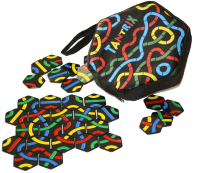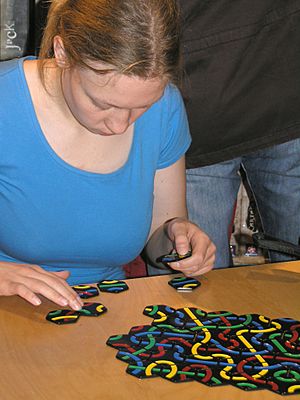Tantrix facts for kids

Players place hexagonal tiles to create the longest line or loop.
|
|
| Publication date | 1988 |
|---|---|
| Players | 1–4 |
| Setup time | 1 minute |
| Playing time | 30 minutes |
| Random chance | Medium |
| Skill(s) required | Strategic thought |
Tantrix is a fun tile-based game created by Mike McManaway in New Zealand. It uses 56 unique hexagonal tiles. Each tile has three lines that connect its edges. These lines are always in different colors. The game uses four main colors: red, yellow, blue, and green. Every tile is special and has its own number from 1 to 56.
Contents
How to Play Tantrix
In the multiplayer version of Tantrix, up to four players can join. Each player picks a color they want to focus on. To start, everyone draws one tile from a bag. The player with the highest numbered tile gets to go first.
After deciding who goes first, each player takes five more tiles from the bag. You should have six tiles in front of you, face up. The first player places one tile on the table. They usually try to play a tile that has their chosen color on it. Then, play moves to the next person in a clockwise direction.
After you play a tile, you pick a new one from the bag. This way, you always have six tiles ready to play. When you place a tile, its lines must match the colors of any tiles it touches. It's like connecting a puzzle!
Understanding Forced Spaces
Sometimes, when you place tiles, a small empty space is almost completely surrounded by three tiles. This is called a forced space. If you have a tile that fits perfectly into this forced space, you must play it. You keep filling any forced spaces you can.
Once you can't fill any more forced spaces, you get to make a "free move." This means you can play any tile you want, as long as you follow three simple rules:
- You cannot create a forced space where the same color line leads into it three times.
- You cannot create a four-sided forced space (these are not allowed in the game).
- You cannot play a tile that, after filling other forced spaces, would create a four-sided forced space.
When there are no more tiles left in the bag to draw, these three rules no longer apply.
Winning the Game
The main goal of Tantrix is to create the longest line or loop of your chosen color. Each tile in your longest line counts as one point. If you make a loop with your color, each tile in that loop counts as two points! Only your highest-scoring line or loop counts towards your final score.
Playing Tantrix Online
Even though it's not as huge as some other online games, Tantrix has a dedicated group of players from all over the world. They compete against each other or against computer players. Players earn points based on their wins and losses. The highest score you can get is 1000 points, which is very hard to reach!
If you reach 950 points, you can earn a "Tournament Ranking" and eventually become a "Master." Masters get to play special "master games" with a different scoring system. Only a few players ever become Masters, as there's a limit of 120 Masters in total.
Serious Tantrix players often join online tournaments each year. Winners get bragging rights and sometimes a small trophy. These events are a big challenge for dedicated players.
World Championships and Tournaments
The WORLD TANTRIX CHAMPIONSHIP starts every August and lasts about four months. It began with only 47 players in 1998, but by 2006, over 200 people were competing! The tournament starts with a qualifying round, where lower-ranked players try to get into the main 128-player knockout tournament.
There are also other big online tournaments each year:
- The World Team Tantrix Championship (WTTC): Teams of five players from the same country or region compete. This started in 2002.
- The World Junior Tantrix Championship (WJTC): A special championship for players under 16. This also started in 2002.
- The World Doubles Tantrix Championship (WDTC): Players team up in pairs. This began in 2005.
There are also three continental tournaments:
- The European Championship (Euro): The biggest tournament for Europe, first held in 1999.
- The Pan-American Tantrix Championship (Pan-Am): For players in the Americas, started in 1999.
- The Afro-Asian Championship (AsAf): For players from Africa and Asia, re-established in 2004.
Many countries also have their own online tournaments, like New Zealand, Australia, Hungary, Sweden, France, and Germany.
Face-to-Face Tantrix Games
Besides online play, offline tournaments, called 'Table Opens', are becoming more popular. The first British Open in 2002 was mostly for local players. But as more people started playing, players began traveling to compete. Table Opens in Europe became very popular because there were more players there. By 2009, there was enough interest to hold a World Tantrix Open!
Past World Table Opens
- 2014 World Tantrix Table Open (Bischoffen, Germany) [1]
- 2013 World Tantrix Table Open (Trosa, Sweden) [2]
- 2011 World Tantrix Table Open (Almere, Netherlands) [3]
- 2010 World Tantrix Table Open (Budapest, Hungary) [4]
- 2009 World Tantrix Table Open (Edinburgh, United Kingdom) [5]
National Table Opens
Many countries also host their own Table Opens, including:
- The British Table Open (since 2002)
- The New Zealand Table Open (since 2004)
- The Swedish Table Open (since 2004)
- The German Table Open (since 2005)
- The French Table Open (since 2005)
- The Spanish Table Open (since 2005)
- The Hungarian Table Open (since 2005)
- The Dutch Table Open (since 2006)
- The Polish Table Open (since 2007)
- The Australian Table Open (since 2007)
- The Israeli Table Open (since 2007)
Images for kids
See also
 In Spanish: Tantrix para niños
In Spanish: Tantrix para niños


































































